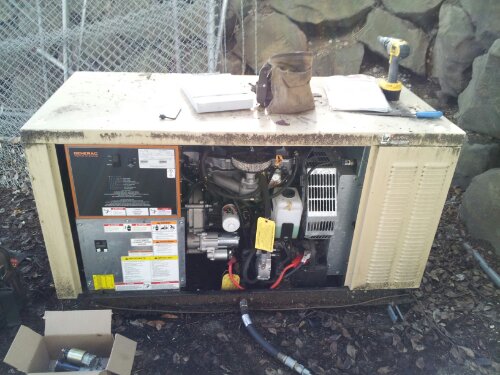Washington Electric wants you to have a good “relationship” with your generator. And as all of us know, maintaining a relationship means we cannot just ignore our old reliable partner. Periodically we need to show a little love-and-attention proving we still “care”.
Yes, this is very true for our standby generators. If we want to make it to our 20 year anniversary, simple maintenance is required. All generators require periodic oil and filter changes to ensure reliable service and maximize longevity. We offer annual maintenance contracts, and also sell preventative maintenance kits to make sure you have a worry-free ownership experience.
The picture below is from a 25Kw generator we serviced yesterday in Seattle. The inspection sticker was from 1999. The business owner told me that it had worked great during this last outage and ran for 12 hours providing power to both the servers and AC units in the server room. After all these years the starter motor needed to be replaced. We ordered a replacement starter motor on Monday, it was delivered on Tuesday, and we had it installed the same day. The bottom line is that the generator had a problem but within 48 hours the part was delivered and installed for our customer. It’s great to get calls for new installations, but it’s also important to keep existing Generators working.
The top 5 generator problems that we fix are:
- 80% of the time replacing a dead battery (These need to be replaced every 2.5 years)
- Fixing a coolant leak
- Fixing a faulty sensor or error message
- Repairing oil or fuel leaks
- The generator is left in the “off” position (I know this sounds simple but this happens more that you might suspect)
A good preventative maintenance program should include the following:
- Lube oil and filters change (use 5/30 synthetic oil)
- Verify fuel supply
- Service or replace air filter, parts not included
- Visual check for oil, water or fuel leaks
- Inspect hoses
- Inspect and tighten belts
- Check for oil moisture, dirt; clean as necessary
- Check emergency system operation without load
- Check frequency and governor operation; adjust as necessary
- Check battery charger
- Check gauges and meters for proper operation and reading levels
- Check generator auto shutdown system and alarms
- Check automatic transfer switch and accessory operation
- Emergency system operation with load transfer during normal daytime hours (with owner’s permission only)
- Inspect for vermin
